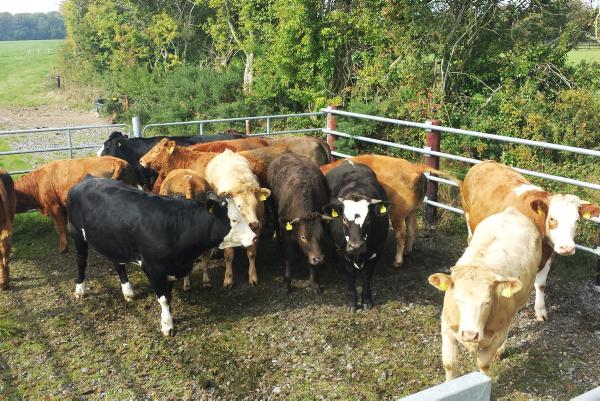In what was a deviation from the usual heat detection-based routine, the 2013 heifer calves were rounded up last week for scanning. There were a couple of reasons for the decision.
As you can see some of the animals boast menacing sets of armoury. These will need to be whipped off if they’re to enter the breeding herd. Last spring we decided to leave the buds in at dehorning. We understood the biology was that the blood supply would be cut off to the area once the iron went deep enough. But, for a number of the calves it obviously didn’t. Lessons were learned and in 2014 all buds were removed.
Secondly, it’s nearing the 20 month mark for many of these ladies, and we would like to see them gone before the rest of the herd is housed. Though ten were earmarked for breeding, fourteen were served. All empty heifers will be brought home in the coming days and finished over 50-60 days as described last week.
Empties
Thankfully, the heifer I have earmarked to buy scanned pregnant. Though I’ll admit my pulse quickened slightly as she went up. The two animals before her had scanned empty. In all there were four empties. Two of the original ten were empty as well as two of the four extras. It was a strange result as I thought our management had been impeccable. All calves had been right on the 400kg mark at breeding and were rotationally grazing a highly productive reseeded pasture. They’ll calve down at an average age of 24 months, well ahead of the Irish average of just over 32 months.
I guess even the most intrinsic heat detection routine will miss a couple here and there. Perhaps the hot weather meant that they spent their days lying in the sun as opposed to mounting. It raises the old question again. Is there a need for a clean-up bull?
Genetics
I would argue no. What’s working for us now is the constant influx of top genetics into what is already a high genetic merit herd. Do we need to replace a fixed number each year just because it’s the done thing? Again, I would argue no. Once an animal’s calves consistently do well, she is well-mannered and relatively healthy; why cull? A heifer from a maternally biased Limousin sire, is still a Limousin. Likewise for the Simmental and Charolais breeds. She should still kill in excess of 340kg at 20 months of age. The security of our heifer enterprise is one of our strengths I feel. Save for a couple of kilos of concentrates and extra time spent managing grass, inputs are minimal.
I ran the plate meter across the heifer block the same day we scanned and found growth to be round about the 70kg DM/ha/day figure. We must bear in mind that this is a figure for last week though and it has gotten slightly cooler.
Broken bone
A broken elbow whilst on duty for the UCD football team during the week has rendered me housebound and thus unable to take a farm cover. I’ll be glad of the rest but still wish it could have happened closer to calving season and not when things are quiet. No doubt the brother and father have other opinions.
Though quite impressive, a quick glance at the Better Farm rates tells me that it isn’t out of the ordinary for the region. God bless the Indians and their summers. We will begin the final rotation in three weeks and aim to hit 5 cm to ensure that we have the best quality possible in the sward when turnout comes about.
*Ciarán Lenehan is currently completing a PhD in suckler bull beef finishing systems at Teagasc Grange, as well as being actively involved in his family’s suckler calf-to-beef enterprise,. He graduated from UCD in 2013 with a degree in Animal Science and has a keen interest in all types of sports.






 This is a subscriber-only article
This is a subscriber-only article














SHARING OPTIONS: